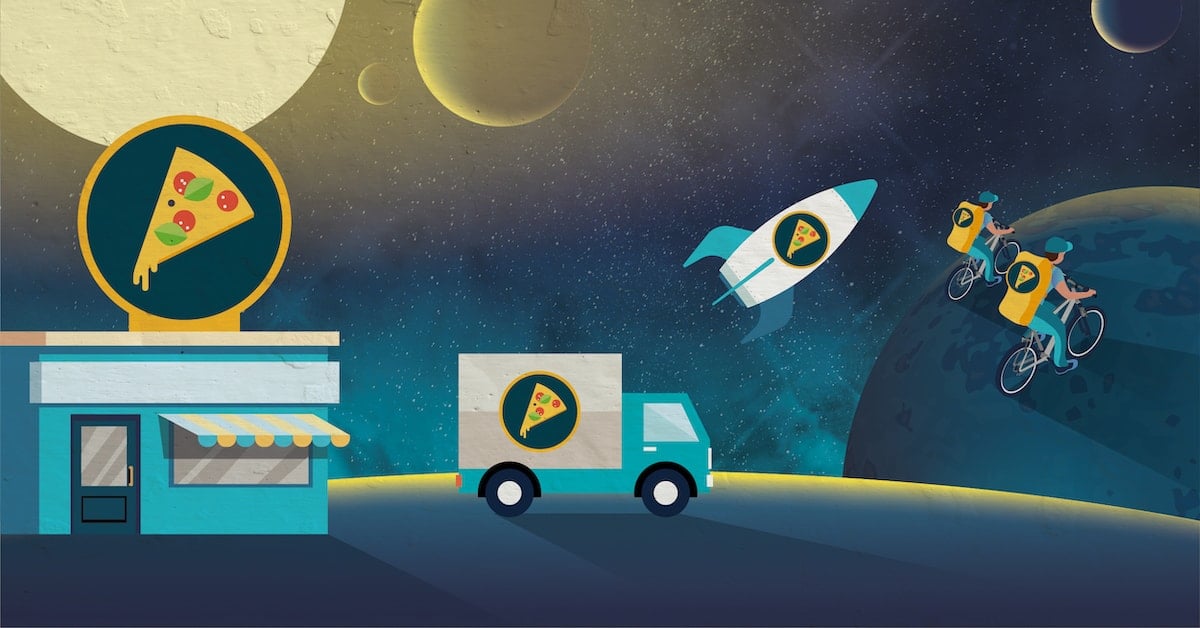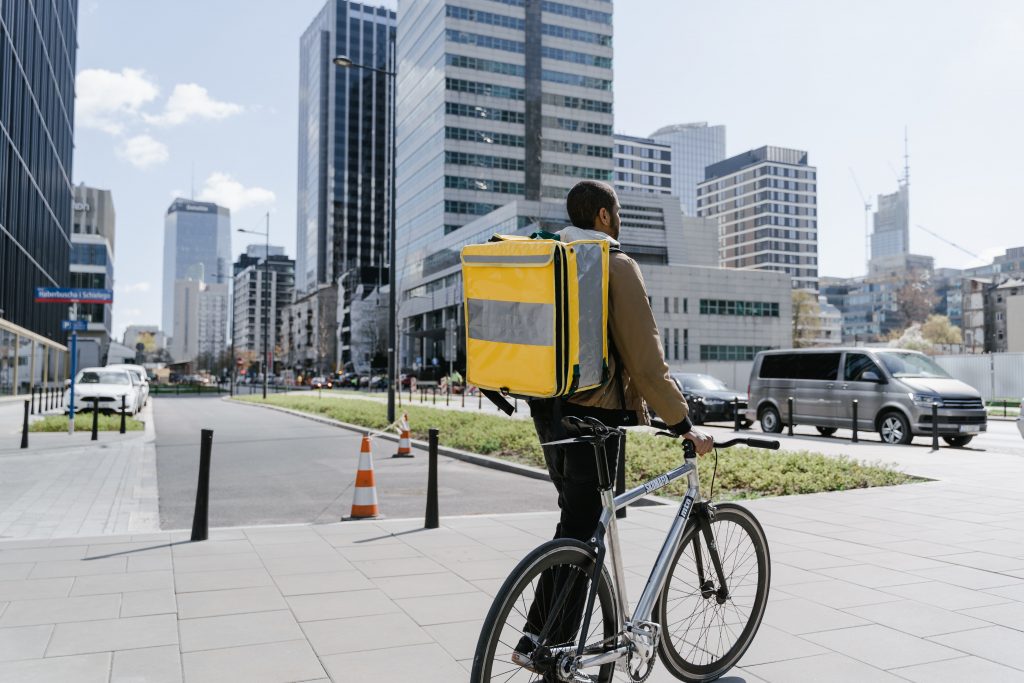Dealing With Guests in Hospitality: Why It’s Critical for Your Success
Dealing with guests in hospitality is more vital than ever. Discover how to improve guest satisfaction and service quality – even with fewer staff.
What are the advantages of starting your own restaurant delivery service? What makes this different from external delivery services? Read more here.

Ever since the beginning of the COVID-19 crisis, ordering food and drinks from online food delivery services has been booming. We are all witness to this, whether as restaurateurs or consumers. The figures also speak for themselves. For example, a U.S. study concluded that during the COVID-19 crisis, 25 % of the surveyed customers placed an order online a few times a week.
Despite the fact that restaurants have since reopened, online food delivery still appears to be increasing. The question is, is it better to join an external delivery service or offer your own restaurant delivery service? I would like to get to the bottom of this in this Utopia Gastronomica article.
The large delivery service operators in Germany, Austria and Switzerland, such as Lieferando or Mjam, as well as in the U.S. like Grubhub or Uber Eats bring a number of advantages. For example, they offer a wide reach, allowing hospitality businesses to attract even more customers. This is useful for restaurants that are just starting out and are in the process of building a customer base. In addition, these third-party delivery operators have a variety of services: They provide delivery staff, have ordering portals in form of websites and apps, and handle guest billing. This saves the restaurant a great deal of administration and work, while at the same time increasing its revenue.

Despite the increase in brand awareness and the possibility of an additional source of revenue, the use of external delivery services is also very challenging. The main challenge is the commission that is charged for each order. Typically, third-party delivery services charge a fee of 15–30 % commission per order. Furthermore, commissions are also determined by whether the restaurant hires its own drivers or hires drivers from the delivery service. For example, Lieferando charges 30 % commission if a Lieferando driver does the delivery. If, on the other hand, the restaurant delivers its own food, the commission is 13 %.
With that said, there is widespread concern that restaurant owners have become too dependent on delivery services. The major concern is that the platforms will exploit their position and drive up commissions. Restaurant owners should carefully review the respective terms and conditions of the various delivery services before agreeing to collaborate. This can help ensure that both parties benefit from the partnership.
In the age of COVID-19, alongside restaurant delivery, supermarket delivery services have become very popular. The German company Gorillas, which promises delivery within 10 minutes, is a great example for this. Orders are assembled in warehouses in centrally located neighborhoods, and then delivered on bicycles. However, the question remains as to whether this business model can work long term – especially during the current social developments. Supermarket delivery services, for example, have been criticized for the poor working conditions of their drivers.
To escape commissions and delivery dependency, restaurants can set up their own delivery service. This requires thorough analysis, budgeting, planning, and patience, which does not happen overnight. You should think of building and starting your own delivery service as a stand-alone process. As is the case with any new restaurant business, it's necessary to devise a well-thought-out concept. To do this, you should consider the following points:
Scope out your competitors through detailed research and analysis. Compare offers, prices, and product range. How popular are they? How long is their average delivery time? Evaluation portals can give you valuable insight into this.
The location of a delivery service also plays a crucial role in how successful it is. Determine exactly how big your delivery area can be and make sure that delivery times are manageable.
The analysis of your target group is dependent on the local community. Therefore, adjust your area of influence to your target group, to make maximum profit.
Once you have given these points sufficient thought and have drawn up a concept, you can begin to look into the necessary resources. Same as with external delivery services, you will need extra space for food preparation. Additionally, the following factors should be considered:
It's important to decide which mode of transportation you want to use to have your orders delivered. Should it be bicycles, scooters, or cars? Furthermore, you need to make sure that you have parking spaces available for the vehicles at your restaurant.
Not only do you need additional staff to deliver the orders, but you also need someone to take care of the entire process. They will be responsible for taking orders, making sure the food is prepared correctly, and checking the orders before they leave the restaurant.
You must also ensure that the guest experience is consistent on-site and off-site. Therefore, how the food arrives at the customer's home is important. You need suitable transportation containers and packaging material that will maintain the temperature of the dishes, whether they are hot or cold.

Since you can't use platforms like Lieferando or Grubhub, you will need your own ordering system on your website. It needs to be easy to use and you need to determine how the payment process should work. Does the customer pay at the time of ordering or upon delivery? Which payment methods are accepted? How will the customer receive an invoice?
In the restaurant, you also need a reliable delivery tracking system. This way, you can see where your drivers are and know when your staff is ready to deliver the next orders.
Marketing is essential to ensure the right reach as well as customer loyalty. This is not just about having an appealing website with a digital menu and an easy-to-use ordering system. You should equally rely on online advertising techniques to reach customers. These include active social media marketing, paid advertisements, and advertising on hospitality platforms.
All of these entail a certain time and cost factor. However, in the long run, this investment will be worth it for your business. You won't have to hand over a high percentage of your profits to external delivery companies, and you'll always retain full control over operations.
More and more restaurant guests prefer direct delivery from a restaurant over that from an external delivery service. This offers customers more individuality and independence. Food is not ordered from a large platform, but from a delivery service developed especially by the restaurant. According to a survey, trust plays a decisive role here. 35 % of restaurant guests place more trust in the employees of a restaurant, than in the employees of third-party delivery services. 57 % also state that they prefer for the restaurant to handle the entire process.
Regardless of whether an external or in-house delivery service is used for the restaurant, it should be noted that not every gastronomic concept is eligible for delivery. For example, this applies to gourmet restaurants that offer food of the highest quality and arrange it beautifully on the plates. When delivered, the food would lose quality in the form of its expected gourmet presentation. Furthermore, dishes that bring a high profit margin are more suitable for delivery. Therefore, it is important to know about the top sellers and slow sellers in your menu.
In addition to the suitable food selection for delivery, you should also evaluate at which point the delivery service is actually profitable. Calculating the break-even point – the point at which costs equal revenue – will allow you to determine this. This can be calculated using the following formula:
Break-Even Point = Fixed Costs ÷ Contribution Margin Ratio
Use the following formula to calculate the contribution margin ratio:
Contribution Margin Ratio = (Sales – Variable Costs ÷ Sales)
Let's assume a restaurant runs its own delivery service and has monthly fixed costs of $6,600, variable costs of $6,000 and sales of $15,000. If you substitute these figures into the formula, you get the following break-even point: $11,000. This means that this is how much turnover must first be achieved, in order to cover all of the costs. If the restaurant earns more than $11,000, it makes a profit.
Both options can be of particular interest to restaurateurs. With external delivery services, you are provided with numerous services and benefit from a large platform that is well positioned, in terms of marketing. However, this also comes with certain costs. The commissions of these delivery portals are fairly high. You need to calculate the whole matter very carefully and weigh out whether such an investment is worthwhile for your business.
Restaurants often significantly underestimate the financial benefits of having their own delivery service.
If you expand your restaurant to having its own delivery service, you'll have to start from scratch, but you are guaranteed more individuality and independence. Of course, it’s also necessary for you to invest time and money, but there are no fees involved. Sooner or later, restaurants that work with third-party delivery services will realize that they are missing out on a high profit percentage of their business.
As is with any investment, it's important to weigh both options carefully and do the math. To stand out from the crowd, starting your own delivery service is the way to go. Go through the individual analytics carefully and evaluate what you need to make this happen. Start small, see how it goes and then make the necessary adjustments, so that you can make the most out of your business.
Dealing with guests in hospitality is more vital than ever. Discover how to improve guest satisfaction and service quality – even with fewer staff.
We show you how we as a company approach the path towards sustainability and what ideas we have developed to achieve this. Read more here.
Learn about the franchise model in the restaurant industry, what it takes to open a restaurant as a franchise, and which companies are already doing...
Make sure you never miss out on updates and trends about digitalization in the hospitality industry by subscribing to our monthly newsletter. You will receive useful information delivered directly to your inbox.